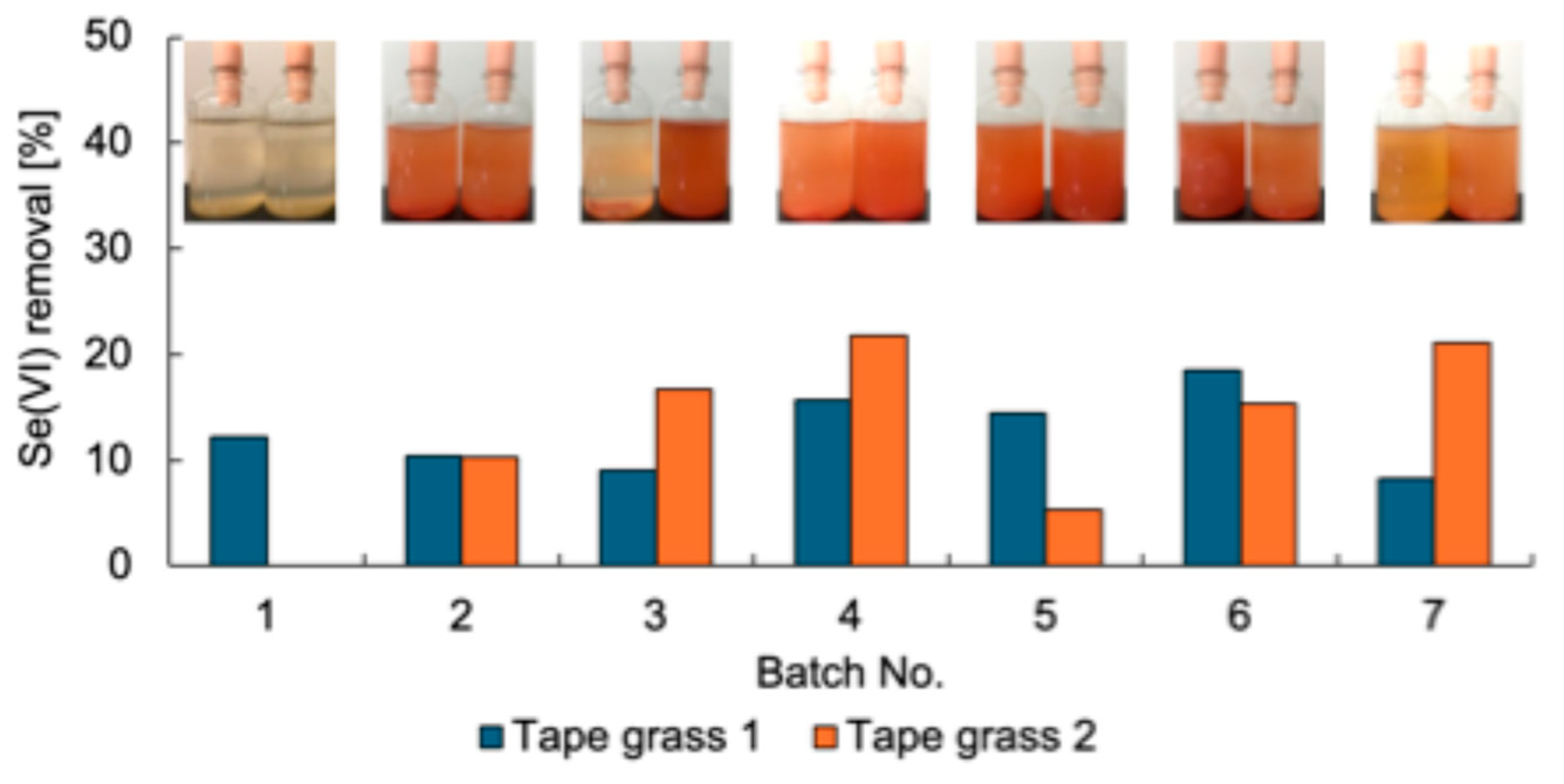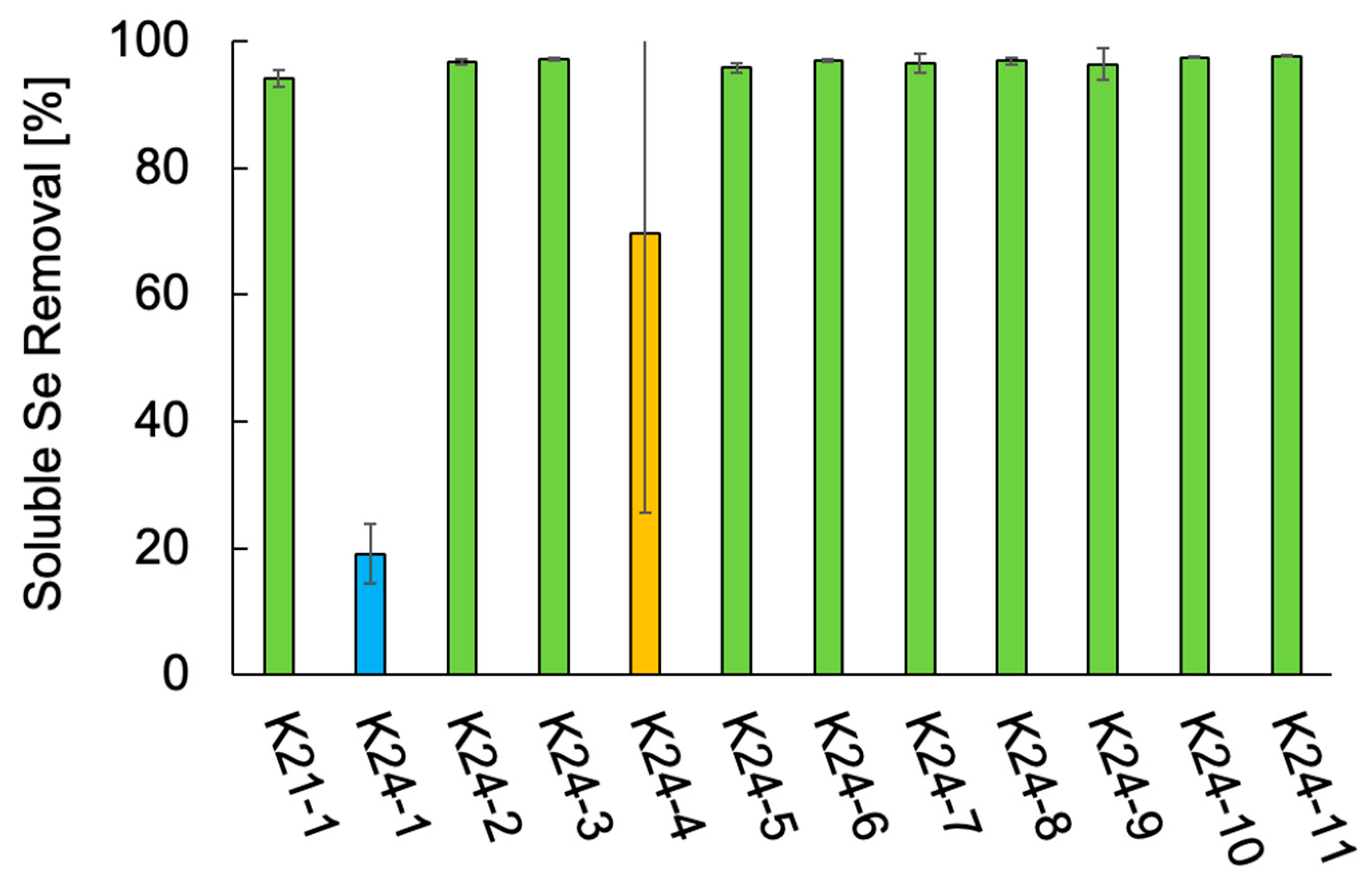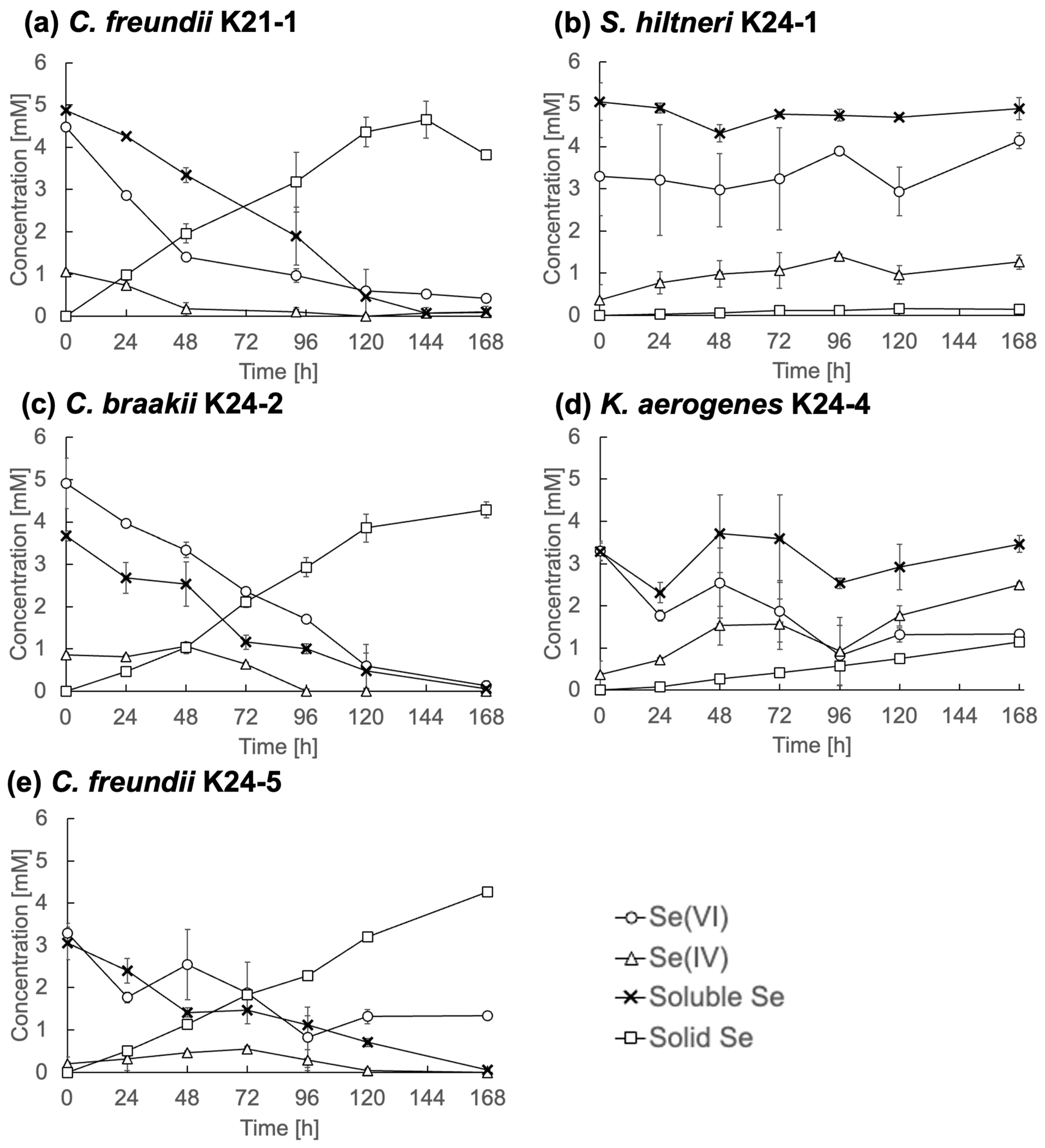Selenium Metabolizing Capabilities of 12 Bacterial Strains Isolated from Urban Environmental Samples
Abstract
1. Introduction
2. Materials and Methods
2.1. Growth Medium
2.2. Environmental Samples
2.3. Enrichment and Isolation of Se-Metabolizing Microorganisms
2.4. Evaluation of the Se Metabolic Potential of the Isolates
2.5. Detailed Analysis of the Se Metabolism of the Representative Strains
2.6. Analytical Procedures
2.7. DNA Extraction and 16S rRNA Gene Sequence Analysis
3. Results and Discussion
3.1. Isolation of Se-Metabolizing Microorganisms
3.2. Evaluation of the Se Metabolic Potential in Isolates
3.3. Se Metabolism in Selected Strains: K21-1, K24-1, K24-2, K24-4, and K24-5
4. Conclusions
Supplementary Materials
Author Contributions
Funding
Institutional Review Board Statement
Informed Consent Statement
Data Availability Statement
Conflicts of Interest
Abbreviations
| Se(VI) | Selenate |
| Se(IV) | Selenite |
| Se0 | Elemental selenium |
| ICP-OES | Inductively coupled plasma optical emission spectrometry |
| FAAS | Flame atomic absorption spectrometry |
References
- Young, T.F.; Finley, K.; Adams, W.; Besser, J.; Hopkins, W.A.; Jolley, D.; McNaughton, E.; Presser, T.S.; Shaw, D.P.; Unrine, J. What you need to know about selenium. In Ecological Assessment of Selenium in the Aquatic Environment; Chapman, P.M., Adams, W.J., Brooks, M.L., Delos, C.G., Luoma, S.N., Maher, W.A., Ohlendorf, H.M., Presser, T.S., Shaw, D.P., Eds.; CRC Press: Boca Raton, FL, USA, 2010; pp. 7–45. [Google Scholar]
- Maher, W.; Roach, A.; Doblin, M.; Fan, T.; Foster, S.; Garrett, R.; Möller, G.; Oram, L.; Wallschläger, D. Environmental sources, speciation, and partitioning of selenium. In Ecological Assessment of Selenium in the Aquatic Environment; Chapman, P.M., Adams, W.J., Brooks, M.L., Delos, C.G., Luoma, S.N., Maher, W.A., Ohlendorf, H.M., Presser, T.S., Shaw, D.P., Eds.; CRC Press: Boca Raton, FL, USA, 2010; pp. 47–92. [Google Scholar]
- U.S. Geological Survey. Selenium. In Mineral Commodity Summaries; U.S. Geological Survey: Reston, VA, USA, 2025; pp. 158–159. [Google Scholar]
- Stolz, J.F.; Basu, P.; Santini, J.M.; Oremland, R.S. Arsenic and selenium in microbial metabolism. Annu. Rev. Microbiol. 2006, 60, 107–130. [Google Scholar] [CrossRef]
- Lenz, M.; Lens, P.N.L. The essential toxin: The changing perception of selenium in environmental sciences. Sci. Total Environ. 2009, 407, 3620–3633. [Google Scholar] [CrossRef] [PubMed]
- Macy, J.M.; Michel, T.A.; Kirsch, D.G. Selenate reduction by a Pseudomonas species: A new mode of anaerobic respiration. FEMS Microbiol. Lett. 1989, 61, 195–198. [Google Scholar] [CrossRef]
- Schröder, I.; Rech, S.; Krafft, T.; Macy, J.M. Purification and characterization of the selenate reductase from Thauera selenatis. J. Biol. Chem. 1997, 272, 23765–23768. [Google Scholar] [CrossRef] [PubMed]
- Krafft, T.; Bowen, A.; Theis, F.; Macy, J.M. Cloning and sequencing of the genes encoding the periplasmic-cytochrome B-containing selenate reductase of Thauera selenatis. DNA Seq. 2000, 10, 365–377. [Google Scholar] [CrossRef]
- DeMoll-Decker, H.; Macy, J.M. The periplasmic nitrite reductase of Thauera selenatis may catalyze the reduction of selenite to elemental selenium. Arch. Microbiol. 1993, 160, 241–247. [Google Scholar] [CrossRef]
- Losi, M.E.; Frankenberger, W.T., Jr. Reduction of selenium oxyanions by Enterobacter cloacae SLD1a-1: Isolation and growth of the bacterium and its expulsion of selenium particles. Appl. Environ. Microbiol. 1997, 63, 3079–3084. [Google Scholar] [CrossRef]
- Lalucat, J.; Gomila, M.; Mulet, M.; Zaruma, A.; García-Valdés, E. Past, present and future of the boundaries of the Pseudomonas genus: Proposal of Stutzerimonas gen. Nov. Syst. Appl. Microbiol. 2022, 45, 126289. [Google Scholar] [CrossRef]
- Kuroda, M.; Notaguchi, E.; Sato, A.; Yoshioka, M.; Hasegawa, A.; Kagami, T.; Narita, T.; Yamashita, M.; Sei, K.; Soda, S.; et al. Characterization of Pseudomonas stutzeri NT-I capable of removing soluble selenium from the aqueous phase under aerobic conditions. J. Biosci. Bioeng. 2011, 112, 259–264. [Google Scholar] [CrossRef]
- Kagami, T.; Narita, T.; Kuroda, M.; Notaguchi, E.; Yamashita, M.; Sei, K.; Soda, S.; Ike, M. Effective selenium volatilization under aerobic conditions and recovery from the aqueous phase by Pseudomonas stutzeri NT-I. Water Res. 2013, 47, 1361–1368. [Google Scholar] [CrossRef]
- Sarkar, P.; Beebe, M.; Bhandari, G.; Wielinski, J.; Lowry, G.V.; Gulliver, D. Novel anaerobic selenium oxyanion reducers native to FGD wastewater for enhanced selenium removal. Appl. Environ. Microbiol. 2025, 91, e0122224. [Google Scholar] [CrossRef]
- Chalita, M.; Kim, Y.O.; Park, S.; Oh, H.S.; Cho, J.H.; Moon, J.; Baek, N.; Moon, C.; Lee, K.; Yang, J.; et al. EzBioCloud: A genome-driven database and platform for microbiome identification and discovery. Int. J. Syst. Evol. Microbiol. 2024, 74, 006421. [Google Scholar] [CrossRef]
- Kumar, S.; Stecher, G.; Suleski, M.; Sanderford, M.; Sharma, S.; Tamura, K. MEGA12: Molecular Evolutionary Genetics Analysis version 12 for adaptive and green computing. Mol. Biol. Evol. 2024, 41, msae263. [Google Scholar] [CrossRef]
- Fujita, M.; Ike, M.; Nishimoto, S.; Takahashi, K.; Kashiwa, M. Isolation and characterization of a novel selenate-reducing bacterium, Bacillus sp. SF-1. J. Ferment. Bioeng. 1997, 83, 517–522. [Google Scholar] [CrossRef]
- Zhang, Y.; Siddique, T.; Wang, J.; Frankenberger, W.T., Jr. Selenate reduction in river water by Citrobacter freundii isolated from a selenium-contaminated sediment. J. Agric. Food Chem. 2004, 52, 1594–1600. [Google Scholar] [CrossRef] [PubMed]
- Zhang, Y.; Frankenberger, W.T., Jr. Removal of selenate in river and drainage waters by Citrobacter braakii enhanced with zero-valent iron. J. Agric. Food Chem. 2006, 54, 152–156. [Google Scholar] [CrossRef]
- Sakagushi, T.; Nakano, T.; Kimura, Y.; Nogami, S.; Kubo, I.; Morita, Y. Development of a genetic transfer system in selenate-respiring bacterium Citrobacter sp. strain JSA which was isolated from natural freshwater sediment. J. Biosci. Bioeng. 2011, 111, 443–447. [Google Scholar] [CrossRef] [PubMed]
- Nguyen, V.K.; Nguyen, T.H.; Ha, M.G.; Kang, H.Y. Kinetics of microbial selenite reduction by novel bacteria isolated from activated sludge. J. Environ. Manag. 2019, 236, 746–754. [Google Scholar] [CrossRef]
- Theisen, J.; Yee, N. The molecular basis for selenate reduction in Citrobacter freundii. Geomicrobiol. J. 2014, 31, 875–883. [Google Scholar] [CrossRef]
- Maddock, D.; Kile, H.; Denman, S.; Arnold, D.; Brady, C. Description of three novel species of Scandinavium: Scandinavium hiltneri sp. nov., Scandinavium manionii sp. nov. and Scandinavium tedordense sp. nov., isolated from the oak rhizosphere and bleeding cankers of broadleaf hosts. Front. Microbiol. 2022, 13, 1011653. [Google Scholar] [CrossRef]
- Zhang, Y.; Okeke, B.C.; Frankenberger, W.T., Jr. Bacterial reduction of selenate to elemental selenium utilizing molasses as a carbon source. Bioresour. Technol. 2008, 99, 1267–1273. [Google Scholar] [CrossRef]




| Sample | Type | Location | |
|---|---|---|---|
| A | tape grass | plant | Tomoe River, Shizuoka, Japan |
| B | vegetable field | soil | Private house A, Shizuoka, Japan |
| C | flower bed | soil | Private house A, Shizuoka A, Japan |
| D | hibiscus | plant | Private house B, Shizuoka, Japan |
| E | garden 1 | soil | Private house B, Shizuoka, Japan |
| F | garden 2 | soil | Private house C, Shizuoka, Japan |
| G | drainage ditch | water | Private house C, Shizuoka, Japan |
| H | green foxtail 1 | plant | Roadside, Shizuoka Japan |
| I | green foxtail 2 | plant | Roadside, Shizuoka Japan |
| J | moss 1 | plant | Shrine A, Shizuoka Japan |
| K | moss 2 | plant | Shrine B, Shizuoka Japan |
| L | seashore | water | Sea front park, Shizuoka, Japan |
| Strain | Source | EZBioCloud_Tophit | ||||
|---|---|---|---|---|---|---|
| Taxon | Strain | Accession No. | Similarity [%] | Completeness [%] | ||
| K21-1 | A | Citrobacter freundii | DSM30039 | AJ233408 | 99.64 | 96 |
| K24-1 | B | Scandinavium hiltneri | H11S7 | OM987267 | 99.72 | 96 |
| K24-2 | C | Citrobacter braakii | ATCC51113 | NAEW01000064 | 99.57 | 94.7 |
| K24-3 | D | Citrobacter freundii | DSM30039 | AJ233408 | 99.57 | 96 |
| K24-4 | E | Klebsiella aerogenes | KCTC2190 | CP002824 | 99.79 | 96 |
| K24-5 | F | Citrobacter freundii | DSM30039 | AJ233408 | 99.36 | 96 |
| K24-6 | G | Citrobacter freundii | DSM30039 | AJ233408 | 99.65 | 96.2 |
| K24-7 | H | Citrobacter freundii | DSM30039 | AJ233408 | 99.72 | 96.5 |
| K24-8 | I | Citrobacter freundii | DSM30039 | AJ233408 | 99.72 | 96.1 |
| K24-9 | J | Citrobacter freundii | DSM30039 | AJ233408 | 99.64 | 96 |
| K24-10 | K | Citrobacter freundii | DSM30039 | AJ233408 | 99.43 | 96.5 |
| K24-11 | L | Citrobacter freundii | DSM30039 | AJ233408 | 99.36 | 95.4 |
Disclaimer/Publisher’s Note: The statements, opinions and data contained in all publications are solely those of the individual author(s) and contributor(s) and not of MDPI and/or the editor(s). MDPI and/or the editor(s) disclaim responsibility for any injury to people or property resulting from any ideas, methods, instructions or products referred to in the content. |
© 2025 by the authors. Licensee MDPI, Basel, Switzerland. This article is an open access article distributed under the terms and conditions of the Creative Commons Attribution (CC BY) license (https://creativecommons.org/licenses/by/4.0/).
Share and Cite
Kuroda, M.; Ishimoto, I.; Kameoka, C.; Kawanishi, T.; Saito, R.; Toki, H.; Yamagishi, H.; Watanabe, Y.; Tani, Y. Selenium Metabolizing Capabilities of 12 Bacterial Strains Isolated from Urban Environmental Samples. Microorganisms 2025, 13, 1675. https://doi.org/10.3390/microorganisms13071675
Kuroda M, Ishimoto I, Kameoka C, Kawanishi T, Saito R, Toki H, Yamagishi H, Watanabe Y, Tani Y. Selenium Metabolizing Capabilities of 12 Bacterial Strains Isolated from Urban Environmental Samples. Microorganisms. 2025; 13(7):1675. https://doi.org/10.3390/microorganisms13071675
Chicago/Turabian StyleKuroda, Masashi, Iori Ishimoto, Chisato Kameoka, Toshiki Kawanishi, Ren Saito, Hajime Toki, Hiroya Yamagishi, Yuzuki Watanabe, and Yukinori Tani. 2025. "Selenium Metabolizing Capabilities of 12 Bacterial Strains Isolated from Urban Environmental Samples" Microorganisms 13, no. 7: 1675. https://doi.org/10.3390/microorganisms13071675
APA StyleKuroda, M., Ishimoto, I., Kameoka, C., Kawanishi, T., Saito, R., Toki, H., Yamagishi, H., Watanabe, Y., & Tani, Y. (2025). Selenium Metabolizing Capabilities of 12 Bacterial Strains Isolated from Urban Environmental Samples. Microorganisms, 13(7), 1675. https://doi.org/10.3390/microorganisms13071675






